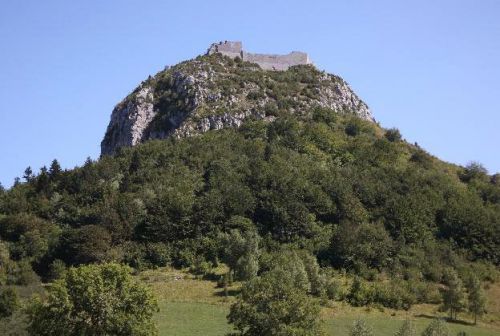Mary Magdalene and the Holy Grail
Mary Magdalene and the Holy Grail, Part 1
(You can link to parts 2 and 3 at the end of the article.)
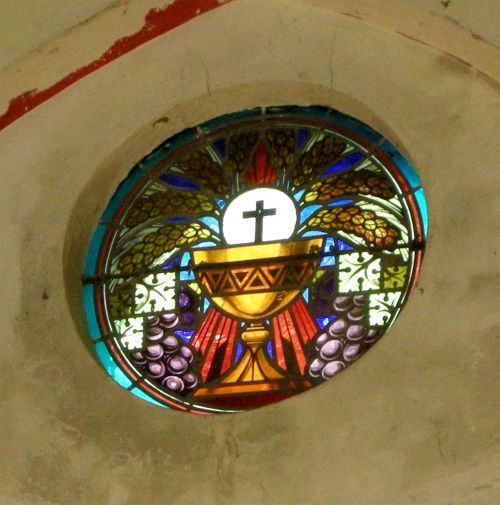 The Holy Grail in the chapel of Celles in Ariège.
The Holy Grail in the chapel of Celles in Ariège.
The Grail exists as a result of the soul’s longing for a solution to the mystery of self-consciousness.
Grail legends have existed throughout history. The Grail is often represented as something physical which materially exists. It can be a jewel, a precious stone, or a holy stone which fell from heaven, or a cup or goblet. It can be an enormous bowl called a Crater, which evokes Celtic origins, or a platter - it’s never simply called a plate - on which is the food of the gods carried by a maiden. For maiden read virgin. (It’s no accident that the “Mary” in the Grail stories, at the time of the Troubadours, was the Virgin Mary.)
The common elements in Grail stories include a great castle perched on top of a precipitous mountain and a sacred glade through which runs a river, whose source never dries up; these are Celtic elements. Through this landscape we follow the adventures of a young man on a quest or journey, throughout which he is tested in trials of physical, emotional and spiritual strength. He has to face daunting challenges, and learning harsh lessons. In the end he reaches Heaven, or Knowledge, or Bliss, or Enlightenment. Or he finds a Treasure - the Grail.
Once the Grail is found, by someone who has passed all the tests and is therefore worthy of possessing it, the object - the Grail - will restore harmony to the world and happiness to humanity. This is of course, what every Knight earnestly desires. However, to some the Grail, called spiritual perfection, becomes a material object or even a simple search for financial treasure.
The Treasure of Rennes-le-Château and the Treasure of Montségur are basically Holy Grail legends, become recently more powerful because Mary Magdalene has been thrown in. She was apparently a priestess to the Cathars, who practised a religion based on love, and she wrote books of wisdom that became the great Cathar treasure, and are still waiting to be found. None of which is historically true. But the Grail is too powerful a concept to resist.
Rennes-le-Château at sunset Montségur, Ariège; a "Grail" castle
Many think of the Grail legends as being of Christian origin but there are pre-Christian similar stories everywhere. There’s a story that Seth, one of the children of Adam and Eve, returned to the Garden of Eden where he was given the Grail by God as a sign that God had not forgotten his people. We hear that the Grail was an emerald stone from the crown of the Light bringer, Lucifer, the Angel of the Morning. During the war between the angels it fell to earth; Lucifer lost the war, and became the Devil.
 Photo Jaap Rameijer
Photo Jaap Rameijer
Author Hannah Closs, writing about the Grail in the 1930’s, compared legends of the East with the Grail stories, often thought to have originated at the time of the Crusades, and tells us “Connections with the Arabs and even long before them were far stronger” than suspected. This Arab connection was merely reinforced when the Crusades began in 1099.
I saw a film recently about the Occitan culture in Languedoc and the Troubadours. The experts had reconstructed the musical instruments and the songs of the Troubadours, and I recognized various harmonies that came from India, for the Occitan songs ended with minor chords. (The music we are used to nearly always ends with a major chord, which makes it more satisfying.) The music traveled across the Mediterranean to Spain and then from Saragossa to Carcassonne; the troubadour culture had begun. And so it seems to me true that that Grail Legends came from the East.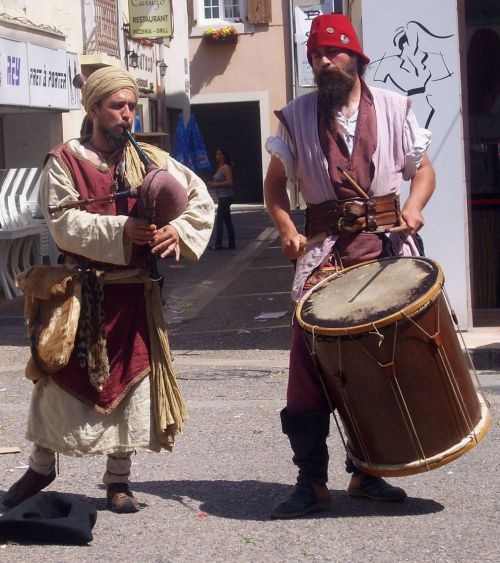 modern minstrels at Lézignan
modern minstrels at Lézignan
The Dark Age Kings and the Waste Land
Between 400AD and 800AD events took place in England and France that were later used in the Grail legends of the Middle Ages. Rival and treacherous kings featured in his story, and a wasteland. The Visigothic king Théodoric, established a brilliant court at Toulouse in 418AD. Then there was a sequence of natural catastrophes - floods, earthquakes, hails of falling stars, dramatic eclipses of the sun - which lasted two years. The darkened sky affected the weather patterns and the crops; there was “a waste land.”
These catastrophes continued. In 469 when King Euric was fighting in central France, there were strange tales of blood spouting in the town centre. In the sky was seen two suns among the stars. (A comet?) When he was fighting in Provence in 472 there was an eruption of Vesuvius in Italy. After 472 the volcano was relatively quiet until an immense eruption in 1631 which killed 18,000 people.
On 26th May 492 there was an earthquake at Ravenna. In the late summer of 526 a comet appeared over Italy and Europe; there were frequent earthquakes.
In France the 5th century Visigothic king Alaric was attacked and killed by the Frankish invaders from the north. Now, like the legendary King Arthur of Britain, he is waiting silently under the Montagne d’Alaric to rise again and ride into battle to save his people.
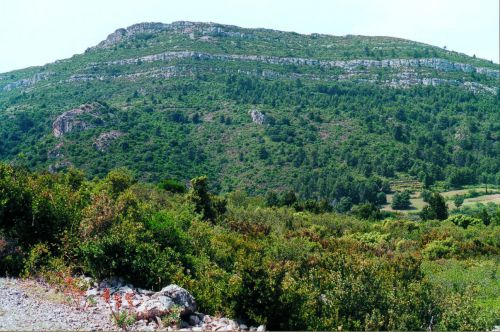
The Montagne d'Alaric, between Narbonne and Carcassonne, where lies buried Languedoc's "once and future king."
Alaric battled with evil and lost; but one day he will return to bring about a peaceful world. King Arthur of Britain, half-Roman, half Celt, was also the rightful king but failed to protect his people from the savage invaders, the Jutes, Angles and Saxons. Like Alaric, Arthur is a “sleeping warrior” who will return to rescue Britain when the time is right. They are both "once and future" kings.
The waste land in Europe continued. In 532 the historian Theophanes wrote; “there was a great running of stars from the evening till dawn, so that all were struck with amazement and said; “the stars are falling “ from the sky, nor do we know of such a thing at any other time.” In 536 there was plague.
I read in the Guardian in September 2002 about scientists who quoted the legend of King Arthur and a “waste land”. They had discovered that a natural global catastrophe shook the world around 540. The skies had darkened, summers were chilly, crops had failed, famine was widespread and one third of the people of Europe perished.
The scientists claimed this wasteland was caused by a cometary bombardment and Arthur had died around 540. It was interesting that the scientists linked this event only to Britain, rather than to Europe, for I found a 13th century reference to a comet in Gaul so big that the sky seemed on fire in either 540 or 541. Was it then, a different catastrophe 122 years earlier, in 418, when Théodoric began his kingship in Gaul? In 1990 three British astronomers calculated the earth had been threatened by cometary bombardment between 400 and 600. So was there a series of catastrophes which lasted around 200 years?
Yes. These catastrophes were caused by violent volcanic explosions.

We know well the explosion of Krakatoa in 1883; the noise was heard 3,000 miles away, shock waves and tunsamis travelled all around the world, while whole towns were buried or borne away by tidal waves. The debris from the explosion was pushed upwards by the crater to reach jet-steams 20 miles high to form a layer of dust three miles in depth, which caused strange sunsets and dark days, and caused a lowering of temperature world-wide.
This volcano had exploded many times before 1883. It had exploded in 416AD and was the cause of the dark skies, the waste land, when the Visigothic Théodoric came to Gaul.
Krakatoa is situated between the south Indonesian islands of Sumartra and Java. A Javanese court poet wrote in the "Book of Kings" about the 416 eruption; A thundering noise was heard from the mountain Batuwara, which was answered by a similar noise coming from Kapi (Krakatoa). A great glaring fire which reached the sky came out of this mountain . . the whole world was greatly shaken and violent thundering accompanied by heavy rains and storms took place. . . the noise was fearful . . Kapi burst into two pieces with a tremendous roar and sank into the deepness of the earth. The water of the sea rose and inundated the land . . the people were drowned and swept away with all their property . . . later the land around Kapi became sea . . and this event was the origin of the separation of Sumatra and Java.
That was in 416 but what about the world-wide catastrophe of around 540 quoted the scientists of the King Arthur story? That also was Krakatoa. Analysis of dust in the ice-cores of the poles dated the event between 510 and 560; the “Book of Kings” dated it precisely as 535. Rome found the skies were veiled and the spring and summer exceptionally cold, there was drought and famine.
These events which caused a “waste land” spanned 200 years. In France they were related to the Visigoths, but in Britain they were related to King Arthur.
The stories of King Arthur and King Alaric are intriguingly similar. Alaric the Visigoth was a much-loved man who tried to keep everybody happy. He had a council of advisers and they were all equal; a sort of Visigothic Knights of the Round Table? Alaric had an illegitimate son called Gesalaric and a legitimate son called Amalaric by his wife. She was the daughter of Théodoric the Great, the Ostrogothic king of Italy. This Théodoric was a manipulator - a Merlin character. He had promised Alaric support against Clovis the Frank. But at a third meeting with Clovis, at which there was no sign of Théodoric, Alaric, with only a routine garrison with him, was attacked. Had he been betrayed?
Alaric returned to his Languedocian strongholds, with his son Amalaric, only 5 years old. There is no mention that Gesalaric, then aged 20, was with his father, and one wonders why. Alaric moved the court to his fortress on the Montagne d’Alaric, to await reinforcements from Théodoric the Great. The reinforcements never came.
That summer of 508, his council saw the Franks slaughtering villagers in their houses and burning the standing corn in the fields. They left a wasteland behind them. Alaric and his knights tried to stop them, and Alaric lost his life in the battle.
There’s a mystery about Gesalaric. Immediately after his father’s death the Visigothic nobles elected him king in Narbonne, then Gesalaric joined his forces with those of his grandfather (Théodoric the Great) which had arrived at last. At the same time Amalaric, as the “true” king, was taken to safety in Rhedae (Rennes-le-Château) by the Royal family. Gesalaric the illegitimate son, jealous of the true king, seems similar to Mordred, the son hoisted on Arthur when he was seduced by Morgan le Fay.
A major part of the Arthurian legends is that Arthur will rise from the dead and come back to protect the British people. Similar legends applied to Alaric. One can still see today the sarcophage of Ragnachilde, Alaric’s mother, in the Musée des Augustins at Toulouse, sculpted with a scene representing the “resurrection of the son of the widow.” This seems a direct statement of the belief that Alaric would rise again from the dead, like Jesus.
It’s no surprise to hear that Alaric is sleeping in an underground chamber on the Montagne d’Alaric, until such a day when he can rise into battle to protect and save the people of Languedoc. Similarly, Arthur of Britain is a “sleeping warrior” who will return to rescue Britain when the time is right.
King Arthur
It’s thought King Arthur lived in the 5th or 6th century, was Romano-British or Romano-Celtic, and tried to protect his country against the Saxons after the Romans had left Britain to her fate in 410AD. Arthur won the battle of Badon against the Saxons in 500AD and then lived and ruled in Powys, at the time covering central England and north Wales. He rebuilt the abandoned Roman town of Virconium (near Shrewsbury) as his headquarters and died around 540. His possible grave is at Berth, a burial site near Virconium that has yet to be excavated.
The official history of the British Isles tells us the Saxons didn’t come until 520AD, when they set up a kingdom with Norwich as its capital. So the dates don’t tie up, unless Arthur was born about 500 and met his end in 540 at the time of the catastrophe? In fact, there are two Arthurs; the real Celtic chieftain trying to hold together his fragmented country in the period immediately after the Romans left, and the legendary Arthur who became the once and future king.
 Arthur killed Mordred in battle.
Arthur killed Mordred in battle.
The English chroniclers were adapting material that had come from France. Wolfram von Eschenbach, who wrote the first Grail story about 1180, said that Arthur’s court was situated at Nantes in Brittany, and Arthur was buried on the Isle of Avallon, until the day he will be needed to take the role of king once again. There is a French town called Avallon, slightly to the west of Vézelay, that was founded around this time.
One of the Grail legends, “Queste del Saint Graal” written between 1215 and 1230, declares that the events of the Grail story occurred 454 years after the death of Jesus, which specifically dates the Grail story to 487AD - Visigothic/Merovingian times.
The legend of Arthur as the once and future king grew up about 600; as did other legends of Kings-that-would-come-back. There are some 70 of them in France alone.
Arthur was sometimes known as Ursus - the name means “bear.” The Visigoths knew of a group of stars they called The Chariot of the Skies, the Little Bear, which gave them navigation from the Pole Star. They often used a bear as their emblem and it featured on their flags.
The Merovingians also worshipped the bear of the Great Bear in the skies and their deity eventually became Arduina, the goddess who gave her name to today’s Ardennes hills in northern France where the Merovingians lived. The name “Ursus”, was also adopted by them, from Mérovée to Clovis. Clovis was baptised by St. Rémy the bishop at Reims in 496. Rémy predicted to Clovis; at the end of time, a descendant of the Frankish kings will reign over all the ancient Roman empire. (This makes it clear that the Roman Church and the Roman Empire were one.) Merovingian kings ruled from 448 to 750AD. The period of their ascendancy, say the authors of The Holy Blood and the Holy Grail, coincides with the period of King Arthur, which constitutes the setting for the romances of the Holy Grail.
The Merovingian kings did no ruling; they were psychic priest-kings. They could heal by the laying on of hands and they could communicate telepathically with men or beasts. They were reputed to be occult adepts. One Merovingian king had a crystal ball and magic talismans buried in his grave with him.
In history the Merovingian bloodline died out around 750, when the last king was murdered by Pepin le Bref, who founded another dynasty unrelated by blood to the Merovingians.
Early Grail stories in France and Spain
Some 300 years later, Guilhem of Gellone, a descendant of Alaric, became a legendary figure after his death in 812. At least six major epic poems were composed about him. Dante, in the Divine Comedy, wrote about Guilhem as an heroic figure.
Guilhem was a true cosmopolitan and a scholar who had studied under Jewish (that is, cabalistic) and Muslim teachers in Toledo. Guilhem spoke Arabic, Hebrew, Gothic and Latin. He collected books and manuscripts and opened a library and Academy of Jewish studies at Gellone, near Montpellier. Later Guilhem converted to Roman Christianity and founded an abbey at his home Gellone, that you can still visit today.
By the early 13th century, Guilhem was called Willehalm and was a member of the Grail family in an epic romance by Wolfram von Eschenbach, who also wrote Parsival.
In this story “Willehalm” was fluent in Hebrew and Arabic, while his shield carried a design representing the Lion of Judah. In Toledo he had met Flegetanis, a man of mixed Jewish and “heathen” descent. Flegetanis was a Hebrew scholar who confided the true story of the Grail to Kyot of Provence, a troubadour who told and sang a tale of mystic quests. Kyot based his story on that of Flegetanis - Guilhem’s student - then gave it to Wolfram von Eschenbach, a Bavarian, who declared in 1180 he was writing the truth “which had come from Provence especially for the people of Germany.” It was then the Germans appropriated the Grail myths as their own, as did writers in Britain.
The Grail stories came to France from the Arabs of Muslim Spain, from Toledo, where had been a great study centre for the wisdom of the Cabbala of the Jews in the time of the Visigoths. From France the legends went to Germany and Britain. There was a Cabalistic school at Toledo, as there was in Gerona in Spain and Montpellier in France.
Flegetanis was Jewish on his mother’s side but why was he a heathen on his father’s side? The reference to learning his abc’s which implies his main language was not Latin but a language that used symbols and not what we call the alphabet today; that is, Arabic, Aramaic or even the old language of the Goths. When you put together various events from the Dark Ages - mysterious or psychic kings, natural catastrophes, the co-operation between Eastern and western philosophies, the slow growth of civilisation defined as idealism, egalitarianism, negotiation and co-operation, it is obvious the origins of the Grail legends arose due to historical events in the years between 400 and 800AD. The “waste land”? It was the result of natural catastrophes at first, but then it was what Charles Martel left in Septimanie after his campaign in 737. He destroyed everything, burning fields and buildings and towns. Poor people had nowhere to live and no food to eat and roamed the burnt countryside like ghosts until they died of hunger.
The Glastonbury legends
By the 12th century the stories became more complicated, with various knights on various quests and the King dealing with problems due to the infidelity of a woman and a treasonable nephew. Versions were re-written in French and German, events were taking place in great forests (Celtic, like Brittany) or in great castles, as in Germany.
In England the Arthur stories were closely linked to the west country. In 1191, monks at the abbey of Glastonbury claimed to have found the graves of Arthur and Guinevere to the south of the Lady Chapel of the Abbey Church, which was visited by a number of contemporary historians including Giraldus Cambrensis. The remains were later moved and were lost during the Reformation. Many scholars suspect that this discovery was a pious forgery to substantiate the antiquity of Glastonbury's foundation, and increase its renown; it’s unlikely Arthur was buried there.
Then at Glastonbury the legends turned suddenly Christian. The legend that Joseph of Arimathea retrieved certain holy relics was introduced by the French poet Robert de Boron in his 13th-century version of the Grail story. It was this story that related how Joseph captured Jesus' blood in a cup (the "Holy Grail") which was subsequently brought to Britain. The earlier versions of the Grail story do not call the grail "holy" or mention anything about blood. The Holy Grail was now defined as a cup. Out of this cup, at the Last Supper, Jesus drank wine; then Joseph of Arimathea took the cup with him to Jesus’s crucifixion, and held it against Jesus’s poor tortured body, so that he could collect the blood of his brother.
Why anybody would do this it is beyond us to know or understand and certainly the Jews, with their horror of uncleanliness, would never have done it or allowed it to happen. However, it was accepted at Glastonbury and pilgrims thronged there in their thousands.
Medieval times are the days of pilgrimages and relics, sometimes called The Cult of the Relics by historians. The employers of the day were obliged by the Church to give their workers forty days off, either to go on a pilgrimage or a crusade. The more interesting the relics that a church had, the more pilgrims they attracted and the churches and cathedrals became rich on this original “spiritual tourism.” Relics of Jesus himself were thin on the ground, for it was believed his body had ascended into Heaven. Many places settled for a relic of the True Cross.
Glastonbury had Jesus’s blood, and some say, sweat too. Joseph of Arithmathea took this to Glastonbury, along with the Virgin Mary, and the earliest church in England was dedicated to her and the cup was placed in it. Later hundreds of pilgrims came to play homage to the Cup and the Virgin. Glastonbury became rich.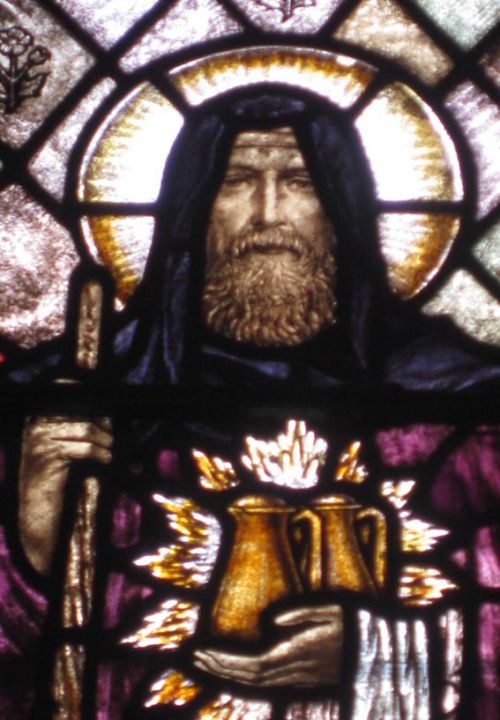 Joseph of Arimathea, carrying Jesus's blood and sweat.
Joseph of Arimathea, carrying Jesus's blood and sweat.
Joseph is said to have arrived in Glastonbury by boat over the flooded Somerset Levels. On disembarking he stuck his staff into the ground and it flowered miraculously into the Glastonbury Thorn (or Holy Thorn). It is true that a species of hawthorn tree called Crataegus Monogyna grows within a few miles of Glastonbury and is not known anywhere else, It flowers twice annually, once in spring and again around Christmas time.
There’s an interesting mountain called Glastonbury Tor, with a church to St. Michael on the top of it. The footpath that winds round it is very old. It’s thought, after excavations done on 1979, this was used by the Celts, and was a maze around the mountain, on which one could find the entrance to Annwn, the Other World or Underworld containing the cauldron, a Grail object. When the Christians arrived, headed by Joseph of Arimathea, they adapted this for Christianity.
Even today, the Tor is thought to have a hidden space inside it, which can be entered but which is full of danger, but you might meet Joseph of Arimathea.


Glastonbury Tor, England; Bugarach Mountain, France
Thus I was fascinated to find a similar modern legend about Bugarach in the Languedoc region, just to the east of Rennes-le-Château. A well-known spiritual tour guide describe how he was taken to a cavern underneath Bugarach to experience an Essene initiation. This mountain, apparently, was riddled with caves used by the Essenes and the Cathars. (Historically the Cathars were never involved with Bugarach, and the Essenes died out in 74AD after Galilee was crushed by the Romans.)
The tour-guide had to enter the cave on all fours without light, he panicked and was told he must conquer his fear. He did so and they proceeded and in the dark he sensed he was on the edge of a precipice - and he was.
They came to a massive cave and waded through icy-cold water into another large cave. As I stepped out of the water onto dry rock I had an amazing experience where I was greeted by several beings, one of which was Joseph of Arimathea, who informed me that I had just completed a major Essene Initiation.
Today Glastonbury Abbey presents itself as "traditionally the oldest above-ground Christian church in the world," which according to the legend was built at Joseph's behest to house the Holy Grail, 65 or so years after the death of Jesus. The legend also says that as a child, Jesus had visited Glastonbury along with Joseph, supposedly his uncle. We now know, however, that Joseph was Jesus’s brother. He was the first one born of Joseph and so named after his father, which was the custom in those days. It was probably Joseph that got married at Cana.
There is however, historical truth in the association of Joseph of Arimathea with Glastonbury. He was a businessman, trading in tin, a wealthy commerce in those days, which took him Cornwall and Angelsey as well as Glastonbury. He founded a church in 64AD, probably for his tin-workers, and was promoted locally and made exempt from taxes on his lands. The church was dedicated, then or later no-one knows, to Santa Maria, the mother of Jesus, hence the Jesus Maria stone in 6th century characters. A Grail expert called Graham Phillips has proved that Joseph of Arimathea and Mary the mother of Jesus, came to Britain after the crucifixion and settled not in Glastonbury but in Angelsey, where they founded the Celtic church based on early Christianity which had no belief in the Trinity.
Then came the Templars
The Templars were an order of Knights who came to the Holy Land in the 12th century. They invented “banking” - you could leave your money with them for a piece of paper and then change the paper back to your own money when you reached your destination. They became rich, but having mixed with the Judaic and Arab cultures, their thinking was not strictly Roman Catholic, and they were persecuted by the Roman Church in the early 14th century, and the Order was disbanded.
But meanwhile, the Templars had tried to teach people hidden spiritual truths by picture cards, thus evading upsetting religious authorities. It’s said they got the idea from the Saracens. The cards became the Tarot cards, which still exist today. The Major Arcana describes the soul’s spiritual journey, the hazards encountered, and the final illumination. This is basically the Grail’s story and message. Many of the people in these cards are women and goddesses.
Some say the cards were used to create new stories by placing them in a different sequence. I find this unlikely, for they are all numbered. They can be laid out in a figure-of-eight-on-its-side style, which represents eternity, and can be seen on some of the cards. There is also a Minor Arcana of four suites, now named swords, wands, cups and pentacles but originally called sword, spear, grail and dish; all part of the Grail legends.
The book “The Templar Revelation” by Lynn Picknett and Clive Prince, persuades us that the figures admired by the Templars were, rather than Jesus, John the Baptist and Mary Magdalene. As far as I can research, this is the first mention of Mary Magdalene connected to the Grail legends.
If you have a Tarot pack, meditate on these cards and the soul’s journey. It’s basically a Grail story, for one ultimately realises illumination - and then you have to go back to the beginning again. Each life is part of a continual cycle. There’s no doubt it is talking about reincarnation and the lessons one learns through each lifetime on earth.



The Empress is a goddess. She has stars around her head like the woman in Revelations and the sign for Venus is on her card. She is a goddess of plenty, and of the earth where ripe corn is growing. The High Priestess is a goddess with the moon at her feet, like the woman in Revelations. Behind her is still water, representing spiritual knowledge, but it is hidden behind a curtain. Can she see into the future? Yet these seem to be two representations or faces of the same woman to me. The maiden (she is wearing flowers) is calming and controlling the lion. This card tells us that real strength is in gentleness. "The soft answer turneth away wrath," Jesus said.
Under the Star called Sirius, a naked woman distributes the water of knowledge and spirituality. This card is one of the luckiest for a woman in a Tarot spread. It indicates hope, inspiration and confidence. Some say she is the goddess Juno, the genius of womanhood. The World is the last card, and signifies illumination. In "Far World" ceremonies, the initiate had to spend 3 days and 2 nights in a cave; then they were led out of the darkness into the light, which at first was blinding. During their deep meditation, they would have seen visions and acquired knowledge. You can compare this to the time Jesus spent in his tomb, and other legends. ("On the third day he rose again from the dead.") It is amazing that the Templars knew of this, from their travels in the East. But what happens after illumination, when the quest is achieved and there is nothing more to know?
There is the paradox. After the treasure is found, or the Truth revealed, the story ends. The initiate knows the secrets and is illuminated. The Quest is completed and then - everything stops.
In the Garden of Eden as in Heaven, everything remains the same. The Treasure is either Death, or Eternal Life, which remains perpetually blissful. Nothing changes. Everything stops the same. Time stops when we die.
A final concept of an unchangeable Heaven is, however, against nature, for in nature everything is changing and moving all the time. You could say that Death itself is not an ending, but merely a change. Some people would say there are no endings because we reincarnate; there is no Nirvana, no ultimate Pleasure Zone. One always needs another mountain to climb.
Life is about the journey, not about the arrival. I find it interesting that the Grail embraces this powerful concept and the Templars apparently believed it, even in the times where reincarnation was considered a gross heresy and you could be punished for believing it.
To read Holy Grail part 2, then click here.
Inscrivez-vous au site
Soyez prévenu par email des prochaines mises à jour
Rejoignez les 261 autres membres


